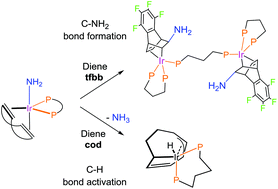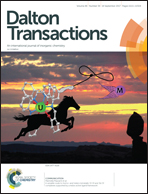Reactivity of the parent amido complexes of iridium with olefins: C–NH2 bond formation versus C–H activation†
Abstract
Herein we report on the different chemical reactivity displayed by two mononuclear terminal amido compounds depending on the nature of the coordinated diene. Hence, treatment of amido-bridged iridium complexes [{Ir(μ-NH2)(tfbb)}3] (1; tfbb = tetrafluorobenzobarrelene) with dppp (dppp = bis(diphenylphosphane)propane) leads to the rupture of the amido bridges forming the mononuclear terminal amido compound [Ir(NH2)(dppp)(tfbb)] (3) in the first stage. On changing the reaction conditions, the formation of a C–NH2 bond between the amido moiety and the coordinated diene is observed and a new dinuclear complex [{Ir(1,2-η2-4-κ-C12H8F4N)(dppp)}2(μ-dppp)] (4) has been isolated. On the contrary, the diiridium amido-bridged complex [{Ir(μ-NH2)(cod)}2] (2; cod = 1,5-cyclooctadiene) in the presence of dppb (dppb = bis(diphenylphosphane)butane) allows the isolation of a mononuclear complex [Ir(1,2,3-η3-6-κ-C8H10)H(dppb)] (5), as a consequence of the extrusion of ammonia. The monitoring of the reaction of 2 with dppb (and dppp) allowed us to detect terminal amido complexes [Ir(NH2)(P–P)(cod)] (P–P = dppb (6), dppp (7)) in solution, as confirmed by an X-ray analysis of 7. Complex 7 was observed to evolve into hydrido species 5 at room temperature. DFT studies showed that C–H bond activation occurs through the deprotonation of one methylene fragment of the cod ligand by the highly basic terminal amido moiety instead of C–H oxidative addition to the Ir(I) center.



 Please wait while we load your content...
Please wait while we load your content...